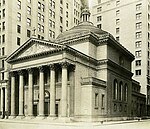Madison Square and Madison Square Park

Madison Square is a public square formed by the intersection of Fifth Avenue and Broadway at 23rd Street in the New York City borough of Manhattan. The square was named for James Madison, fourth President of the United States. The focus of the square is Madison Square Park, a 6.2-acre (2.5-hectare) public park, which is bounded on the east by Madison Avenue (which starts at the park's southeast corner at 23rd Street); on the south by 23rd Street; on the north by 26th Street; and on the west by Fifth Avenue and Broadway as they cross. The park and the square are at the northern (uptown) end of the Flatiron District neighborhood of Manhattan. The neighborhood to the north and west of the park is NoMad ("NOrth of MADison Square Park") and to the north and east is Rose Hill. Madison Square is probably best known around the world for providing the name of Madison Square Garden, a sports arena and its successor which were located just northeast of the park for 47 years, until 1925. The current Madison Square Garden, the fourth such building, is not in the area. Notable buildings around Madison Square include the Flatiron Building, the Toy Center, the New York Life Building, the New York Merchandise Mart, the Appellate Division Courthouse, the Met Life Tower, and One Madison Park, a 50-story condominium tower.
Excerpt from the Wikipedia article Madison Square and Madison Square Park (License: CC BY-SA 3.0, Authors, Images).Madison Square and Madison Square Park
Madison Avenue, New York Manhattan
Geographical coordinates (GPS) Address Nearby Places Show on map
Geographical coordinates (GPS)
| Latitude | Longitude |
|---|---|
| N 40.742054 ° | E -73.987984 ° |
Address
Madison Square
Madison Avenue
10010 New York, Manhattan
New York, United States
Open on Google Maps










